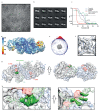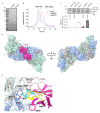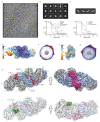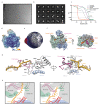Structures of influenza A virus RNA polymerase offer insight into viral genome replication
- PMID: 31485076
- PMCID: PMC6795553
- DOI: 10.1038/s41586-019-1530-7
Structures of influenza A virus RNA polymerase offer insight into viral genome replication
Abstract
Influenza A viruses are responsible for seasonal epidemics, and pandemics can arise from the transmission of novel zoonotic influenza A viruses to humans1,2. Influenza A viruses contain a segmented negative-sense RNA genome, which is transcribed and replicated by the viral-RNA-dependent RNA polymerase (FluPolA) composed of PB1, PB2 and PA subunits3-5. Although the high-resolution crystal structure of FluPolA of bat influenza A virus has previously been reported6, there are no complete structures available for human and avian FluPolA. Furthermore, the molecular mechanisms of genomic viral RNA (vRNA) replication-which proceeds through a complementary RNA (cRNA) replicative intermediate, and requires oligomerization of the polymerase7-10-remain largely unknown. Here, using crystallography and cryo-electron microscopy, we determine the structures of FluPolA from human influenza A/NT/60/1968 (H3N2) and avian influenza A/duck/Fujian/01/2002 (H5N1) viruses at a resolution of 3.0-4.3 Å, in the presence or absence of a cRNA or vRNA template. In solution, FluPolA forms dimers of heterotrimers through the C-terminal domain of the PA subunit, the thumb subdomain of PB1 and the N1 subdomain of PB2. The cryo-electron microscopy structure of monomeric FluPolA bound to the cRNA template reveals a binding site for the 3' cRNA at the dimer interface. We use a combination of cell-based and in vitro assays to show that the interface of the FluPolA dimer is required for vRNA synthesis during replication of the viral genome. We also show that a nanobody (a single-domain antibody) that interferes with FluPolA dimerization inhibits the synthesis of vRNA and, consequently, inhibits virus replication in infected cells. Our study provides high-resolution structures of medically relevant FluPolA, as well as insights into the replication mechanisms of the viral RNA genome. In addition, our work identifies sites in FluPolA that could be targeted in the development of antiviral drugs.
Conflict of interest statement
Figures












Similar articles
-
Structures of H5N1 influenza polymerase with ANP32B reveal mechanisms of genome replication and host adaptation.Nat Commun. 2024 May 15;15(1):4123. doi: 10.1038/s41467-024-48470-3. Nat Commun. 2024. PMID: 38750014 Free PMC article.
-
Host ANP32A mediates the assembly of the influenza virus replicase.Nature. 2020 Nov;587(7835):638-643. doi: 10.1038/s41586-020-2927-z. Epub 2020 Nov 18. Nature. 2020. PMID: 33208942 Free PMC article.
-
Replication and transcription activities of ribonucleoprotein complexes reconstituted from avian H5N1, H1N1pdm09 and H3N2 influenza A viruses.PLoS One. 2013 Jun 4;8(6):e65038. doi: 10.1371/journal.pone.0065038. Print 2013. PLoS One. 2013. PMID: 23750226 Free PMC article.
-
[Transcription and replication of influenza virus genome].Nihon Rinsho. 1997 Oct;55(10):2555-61. Nihon Rinsho. 1997. PMID: 9360371 Review. Japanese.
-
Structural insights into RNA synthesis by the influenza virus transcription-replication machine.Virus Res. 2017 Apr 15;234:103-117. doi: 10.1016/j.virusres.2017.01.013. Epub 2017 Jan 20. Virus Res. 2017. PMID: 28115197 Review.
Cited by
-
Preparation and Antigenic Site Identification of Monoclonal Antibodies against PB1 Protein of H9N2 Subtype AIV.Vet Sci. 2024 Sep 5;11(9):412. doi: 10.3390/vetsci11090412. Vet Sci. 2024. PMID: 39330791 Free PMC article.
-
Detailed Analyses of Molecular Interactions between Favipiravir and RNA Viruses In Silico.Viruses. 2022 Feb 7;14(2):338. doi: 10.3390/v14020338. Viruses. 2022. PMID: 35215932 Free PMC article.
-
Recent Advances in Application of Computer-Aided Drug Design in Anti-Influenza A Virus Drug Discovery.Int J Mol Sci. 2022 Apr 25;23(9):4738. doi: 10.3390/ijms23094738. Int J Mol Sci. 2022. PMID: 35563129 Free PMC article. Review.
-
A Comprehensive Roadmap Towards the Generation of an Influenza B Reporter Assay Using a Single DNA Polymerase-Based Cloning of the Reporter RNA Construct.Front Microbiol. 2022 May 25;13:868367. doi: 10.3389/fmicb.2022.868367. eCollection 2022. Front Microbiol. 2022. PMID: 35694292 Free PMC article.
-
Host Protective Immune Responses against Influenza A Virus Infection.Viruses. 2020 May 3;12(5):504. doi: 10.3390/v12050504. Viruses. 2020. PMID: 32375274 Free PMC article. Review.
References
-
- Pflug A, Lukarska M, Resa-Infante P, Reich S, Cusack S. Structural insights into RNA synthesis by the influenza virus transcription-replication machine. Virus Res. 2017;234:103–117. - PubMed
Publication types
MeSH terms
Substances
Grants and funding
LinkOut - more resources
Full Text Sources
Other Literature Sources
Medical
Molecular Biology Databases
Research Materials
Miscellaneous

